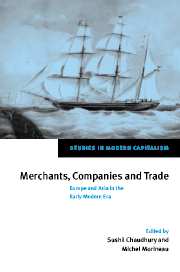Book contents
- Frontmatter
- Contents
- List of contributors
- Preface
- Introduction
- Part I Asia, especially India, around 1500
- Part II Routes, markets and merchants
- Part III European presence in Asia
- 8 The Portuguese and the Dutch in Asian maritime trade: a comparative analysis
- 9 Competition or collaboration? Relations between the Dutch East India Company and Indian merchants around 1680
- 10 The French India Company and its trade in the eighteenth century
- 11 Sweden and India in the eighteenth century: Sweden's difficulty in gaining access to a crowded market
- 12 The ambitions of the Austrian Empire with reference to East India during the last quarter of the eighteenth century
- Part IV Implications of trade: Asia and Europe
- Index
11 - Sweden and India in the eighteenth century: Sweden's difficulty in gaining access to a crowded market
Published online by Cambridge University Press: 02 December 2009
- Frontmatter
- Contents
- List of contributors
- Preface
- Introduction
- Part I Asia, especially India, around 1500
- Part II Routes, markets and merchants
- Part III European presence in Asia
- 8 The Portuguese and the Dutch in Asian maritime trade: a comparative analysis
- 9 Competition or collaboration? Relations between the Dutch East India Company and Indian merchants around 1680
- 10 The French India Company and its trade in the eighteenth century
- 11 Sweden and India in the eighteenth century: Sweden's difficulty in gaining access to a crowded market
- 12 The ambitions of the Austrian Empire with reference to East India during the last quarter of the eighteenth century
- Part IV Implications of trade: Asia and Europe
- Index
Summary
Introduction
On 31 May 1727, the activities of the Imperial and Royal East India Company, based in the Austrian Netherlands and better known as the Ostend Company, were suspended under pressure from the great powers of the period – France, Great Britain and the United Provinces. Pressure had been exerted on Emperor Charles VI to terminate all maritime trading activities in the Far East by his subjects, in the shape of a threat that his daughter Maria Theresa would not be recognized as his legitimate successor by these same powers. In the month of April 1732 permissions were accorded to allow the last two vessels of the Company to leave the port of Ostend. These were the final convulsions of a dying East India Company.
On 7 March 1732 the vessel Fredericus Rex Sueciae left the port of Gothenburg for China. It was the first expedition of a bright new East India Company, to which King Fredrik I of Sweden (1720–51), hereditary Prince of Hesse-Cassel and married to Ulrica Eleonora, the sister of the unfortunate Karl XII, had just granted a privilege that allowed it to trade in the Far East (14 June 1731).
The charter for the new Company set out certain privileges which the king delegated to the management of the Company, differing little from those granted to similar Companies abroad. I shall not linger to analyse the juridical framework of this Swedish Company, nor its prehistory; but it should be emphasized that the Swedish monarch strongly supported the new enterprise and was proud to be publicly known as its guarantor.
- Type
- Chapter
- Information
- Merchants, Companies and TradeEurope and Asia in the Early Modern Era, pp. 212 - 226Publisher: Cambridge University PressPrint publication year: 1999



